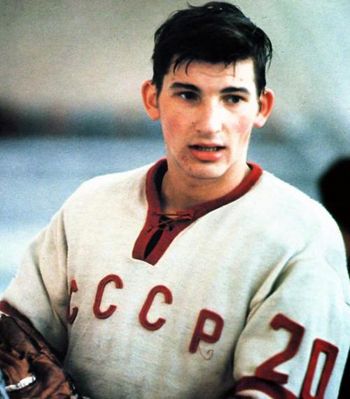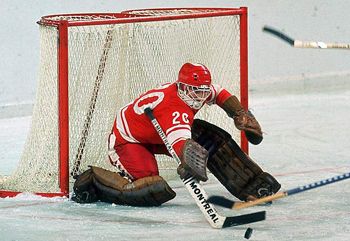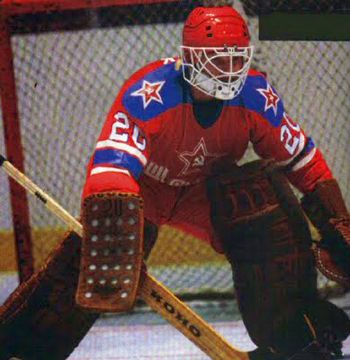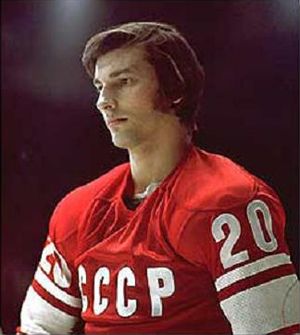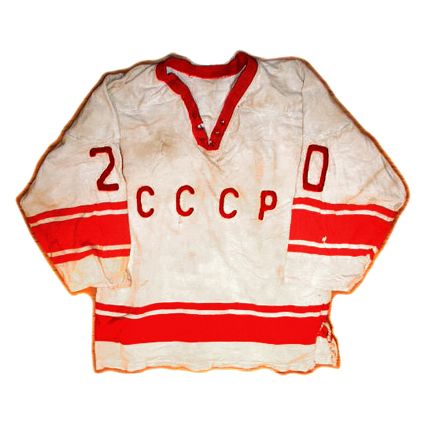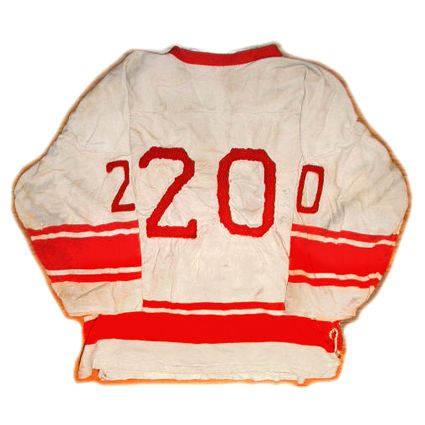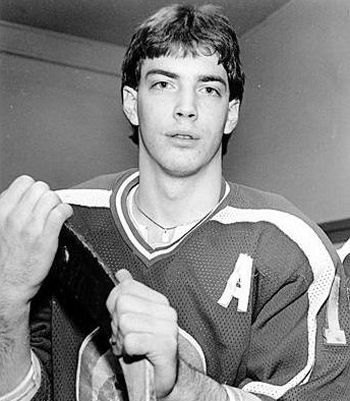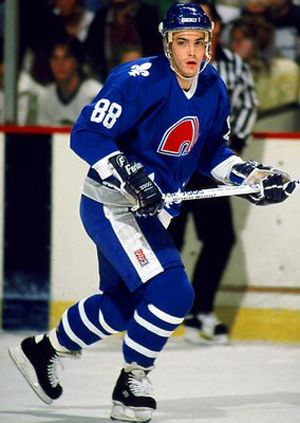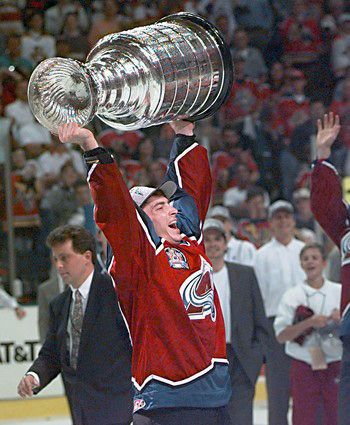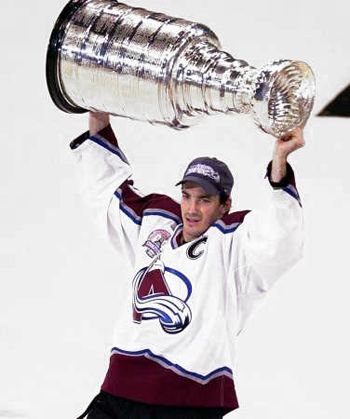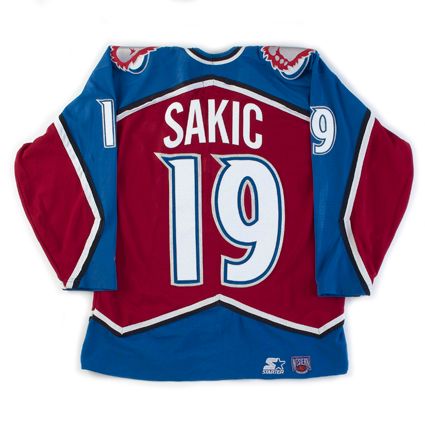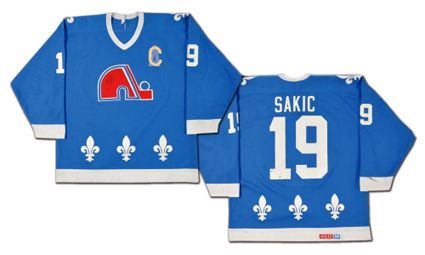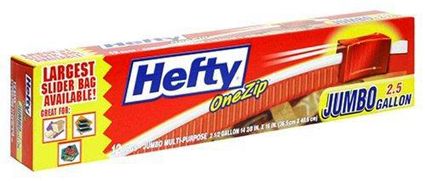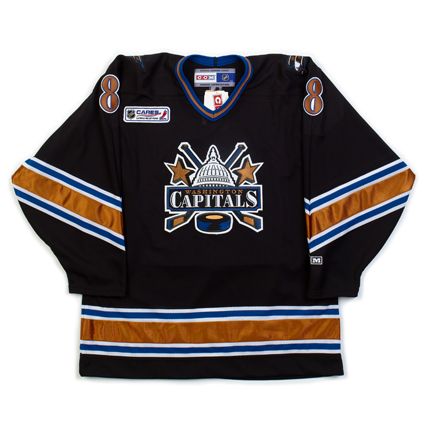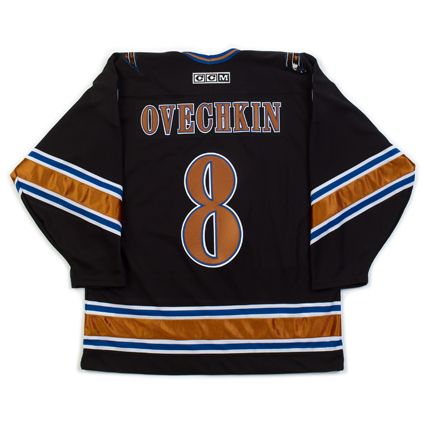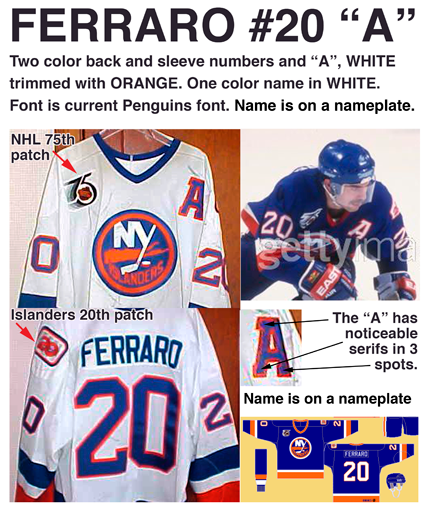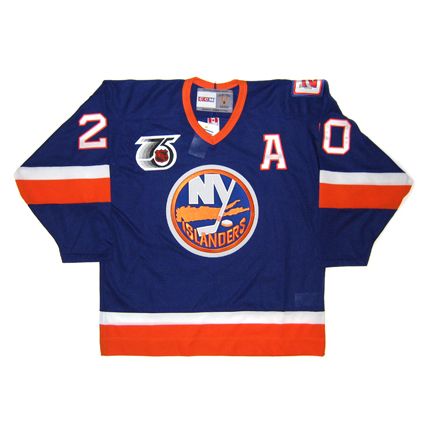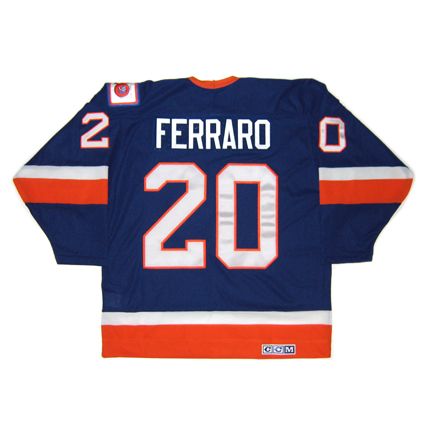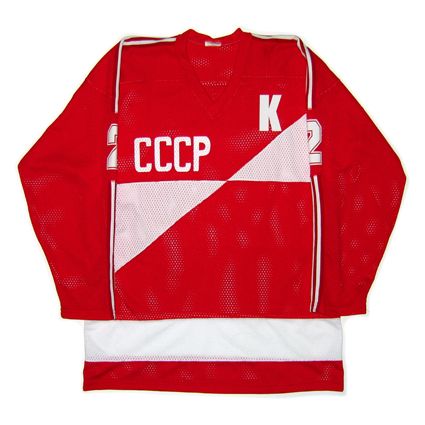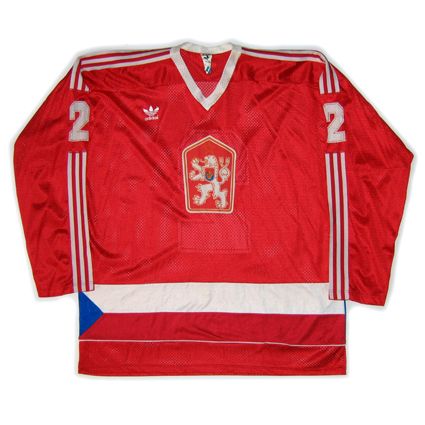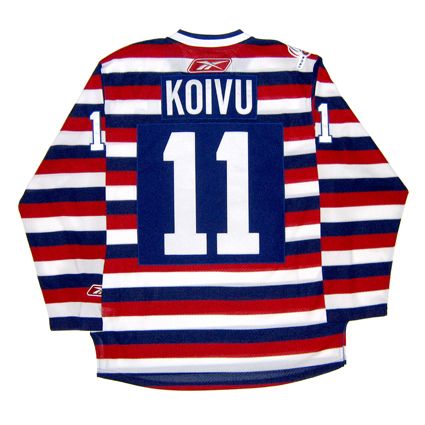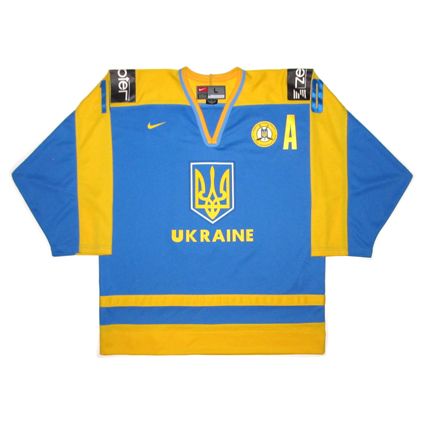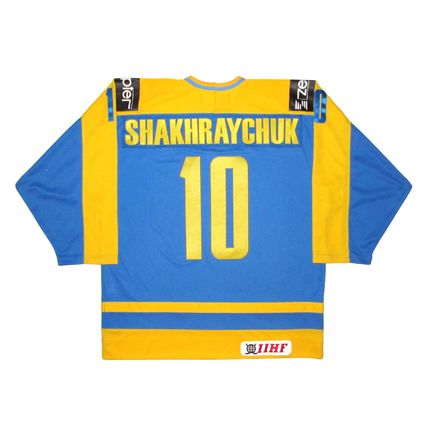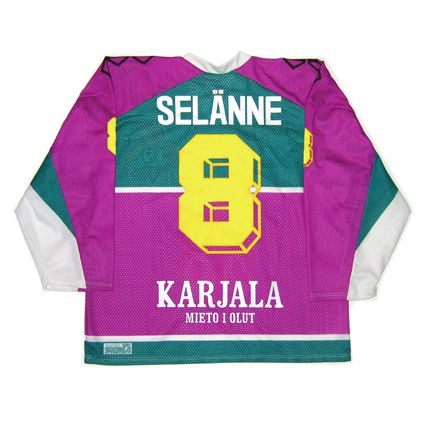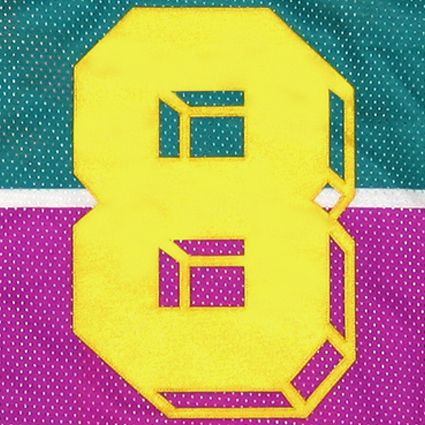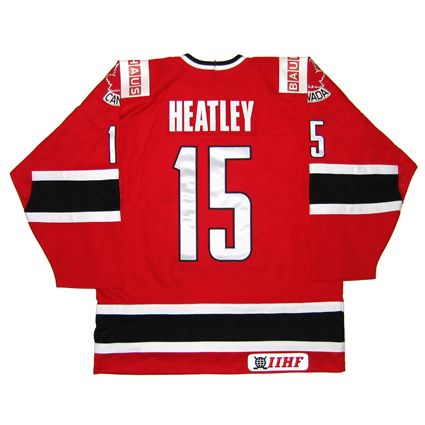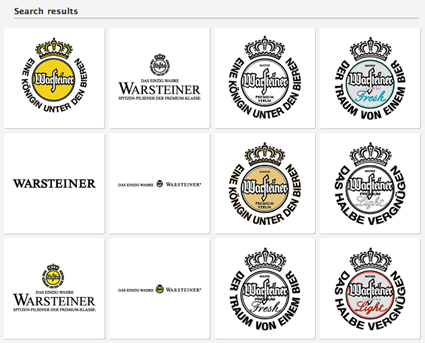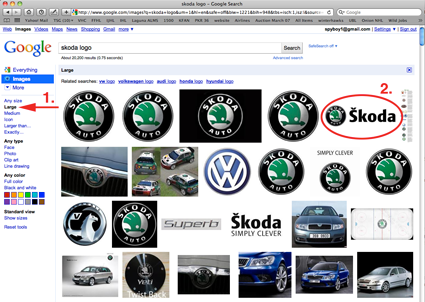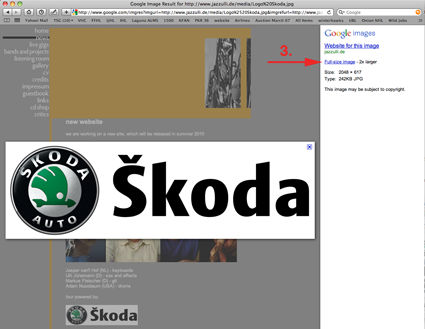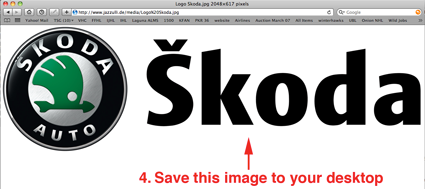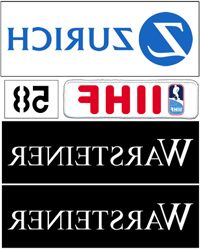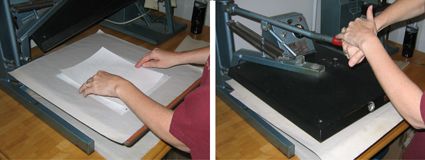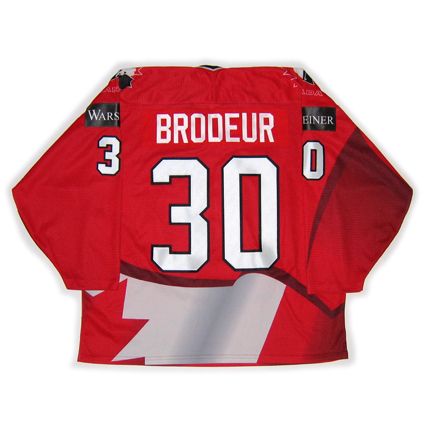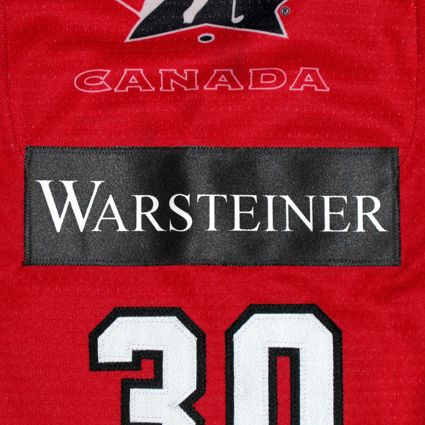from the 1972 Summit Series
Saturday, October 3, 2015
1970 Soviet Union National Team Vladislav Tretiak Jersey
On this date in 1989 hockey history was made, as Vladislav Tretiak became the first European player to be inducted into the Hockey Hall of Fame.
Two Canadian goals before the game was seven minutes old only seemed to reinforce the scouts opinion on Tretiak, which would soon change, as the Canadians would manage just one more goal for the remainder of the contest as the Soviets came alive and pummeled the startled Canadians 7-3.
Although he was drafted by the Montreal Canadiens in 1983 , it was at a time when Soviet players were not allowed to leave for the NHL. Tretiak would spend 15 full seasons playing for Central Sports Club of the Army (CSKA), or as more commonly known, the "Red Army".
Internationally, Tretiak's resume would show three Olympic gold medals (1972 - Japan, 1976 - Austria and 1984 - Yugoslavia), ten World Championship gold medals (1970, 1971, 1973, 1974, 1975, 1978, 1979, 1981, 1982 & 1983) and gold medals in the European Championships nine times. In addition he would be named the winner of the Golden Hockey Stick as the most outstanding player in all of Europe in 1981, 1982 and 1983.
Another career highlight is the 1975-76 Red Army tour of North America, where the Red Army faced off against various NHL club teams, the first time any Soviet club team had faced an NHL team, and came away with dominant victories over the New York Rangers and Boston Bruins and a loss to the Philadelphia Flyers, but the most memorable game was a New Year's Eve contest against the Montreal Canadiens, that season's eventual Stanley Cup Champions, that ended in a 3-3 tie with Montreal out-shooting Red Army 38-13 in a game considered by many to be one of the greatest games ever played.
The many highlights of Tretiak's career appear over and over again of the IIHF list of the Top 100 Stories of the 20th Century. The Soviets victory over Canada in the 1981 Canada Cup ranks as #9, the New Year's Eve game with Montreal #23, the shock opening game of the 1972 Summit Series as #3 and the Soviets victory over the NHL All-Stars in the 1979 Challenge Cup as #36. Even the defeats of the Soviets during the Tretiak era were so uncommon that they merit recognition on the list as well. A loss to Poland in 1976 was #39, the conclusion of the 1972 Summit Series was #2, the loss to the USA in the 1980 Olympics was #1, their loss to the Czechs in 1972 was #5 and in 1974 was #67.
An unknown 20 year old, Tretiak was the starting goaltender for the Soviet National Team as the historic 1972 Summit Series began in Montreal. Since the Canadian scouts had only seen him play once, a dismal performance in which he allowed eight goals against due to excessive celebrations at his bachelor party the night before, he was dismissed as no threat to the best professionals Canada had to offer.
His continued outstanding play in the first half of the series earned him a tremendous amount of respect and admiration as the Soviet showed that they were able to compete with the Canadians. Eventually Canada would prevail in the series by the slimmest of margins, but Tretiak's reputation had been cemented by his play in the series.
During his 15 seasons in the Soviet Hockey League, Tretiak and Red Army would win the championship 13 times and finish runners up the other two. Tretiak was also named the First Team All-Star Goalie 14 consecutive seasons and league MVP five times. Outside of the Soviet Union, Tretiak and the club would take home the European Cup 13 times.
He would also participate in two Canada Cups, earning a bronze with a depleted squad in 1976 and gold in 1981 where he would be named the tournament's MVP. His final goals against average in 98 international games was an outstanding 1.78.
After his early retirement in 1984 at the age of 32, ranked as #37 in the Top 100 Stories of the Century by the International Ice Hockey Federation, due to his desire to face a new challenge and play in North America and the Soviet authorities refusal to grant him permission, the strain of the eleven month a year commitment required by the Soviet hockey system plus friction with his coach Viktor Tikhonov, Tretiak would finally make his way to North America, having been hired by the Chicago Blackhawks as goaltender coach in 1990.
He would become the first Soviet-trained player to be inducted into the Hockey Hall of Fame and the first European voted in without ever having played in the NHL. His induction would be ranked as #55 on Top 100 Stories of the Century. In 2000 he would be voted the Best Russian Hockey Player of the 20th Century and named the Goaltender for the IIHF Centennial All-Star Team. Tretiak would be elected as the head of the Russian Ice Hockey Federation in 2006.
The IIHF Centennial All-Star Team announcement honoring Valeri Kharlamov, Tretiak, Slava Fetisov, Borje Salming, Wayne Gretzky and Sergei Makarov.
Today's featured jersey is a 1970 Soviet Union Vladislav Tretiak jersey. The owner of this fantastic piece of hockey history dates this jersey as having been worn from 1970 to 1972, up until the 1972 Summit Series when they Soviets wore a brand new set of sweaters.
Tretiak would have then worn this beginning at the age of 17 at the 1970 European Junior Championships (gold), followed by the World Championships (gold) as well as the Izvestia Cup (silver). In 1971 the cycle would be repeated with the European Juniors (gold), World Championships (gold) and Izvestia Cup (gold). The routine would change in 1972 with first the Olympics in Sapporo, Japan (gold) followed by the World Championships (silver) later in the spring. If in fact worn for each of those tournaments, which is entirely feasible as all those tournaments would total 34 games in all for both the red and white sweaters, this would have been a gold medal winning jersey six times and a silver twice out of eight tries, making this perhaps the most accomplished sweater in hockey history!
There is an interesting story about Tretiak's subsequent 1972 Canada Cup white sweater, as it was swiped by a young man named Doug Duke following a Soviet practice in Canada, and Duke was able to show it to Tretiak years later.
Today's first video is his introductory video from Tretiak's Hall of Fame induction.
Vladislav Tretiak reunited with his white sweater
from the 1972 Summit Series
from the 1972 Summit Series
Here are highlights from the memorable game between the Red Army and the Montreal Canadiens on New Year's Eve in 1975.
Labels:
Soviet Red Army,
Soviet Union,
Tretiak Vladislav
Thursday, October 1, 2015
1995-96 Colorado Avalanche Joe Sakic Jersey
On this date in 2009, the Colorado Avalanche retired the #19 of long time captain Joe Sakic.
A little known fact is that Sakic's parents were Croatian immigrants and he grew up speaking Croatian before attending elementary school. He would be named Rookie of the Year in the Western Hockey League of Canadian Juniors in 1987 after scoring 133 points. He also survived a horrific bus crash involving his club, the Swift Current Broncos, in which four of his teammates were killed. Sakic was then drafted by the Quebec Nordiques 15th overall in the 1987 NHL Entry Draft.
The following year Sakic was named WHL Most Valuable Player and Canadian Major Junior Player of the Year after scoring 160 points.
The following year Sakic was named WHL Most Valuable Player and Canadian Major Junior Player of the Year after scoring 160 points.
He scored an assist on his NHL debut on October 6, 1988 versus the Hartford Whalers and originally wore sweater #88 because Alain Cote was wearing his preferred #19. He finished with 62 points in 70 games as a rookie.
With Cote now retired, Sakic claimed his #19 for 1989-90 and scored 102 points. 1990-91 saw Sakic score 109 points, sixth overall in the league, and be named co-captain of the Nordiques (for home games).
Sakic would miss 11 games in 1991-92, which would hurt him in his chances to repeat another 100 point season, and he would conclude the year with 94 points. During this time period. the Nordiques regularly finished in last place, which allowed them to load up on high draft choices and put them in position to acquire a number of talented players, highlighted by their trade of holdout Eric Lindros.
Now named full time team captain of the newly reconfigured Nordiques, Sakic would respond in 1992-93 with 105 points and lead the Nordiques out of the wilderness and into the playoffs for the first time in his career on the heels of a staggering 52 point improvement, double their total of the year prior. Without any previous playoff experience, the Nordiques would be eliminated in the first round by arch-rivals the Montreal Canadiens.
1993-94 was a slight step back for Sakic, as he would fall short of the 100 point barrier with 92, but the Nordiques would take a large step back, dropping 28 points in the standings and miss the playoffs yet again.
The Nordiques final season of in Quebec saw Sakic finish fourth in scoring during the lockout shortened 1994-95 season and the Nordiques would capture the division title, only to be eliminated in six games by the New York Rangers, ending their time in Canada.
Relocated to Denver, the Colorado Avalanche took to the ice in the 1995-96 season hoping to continue the improvement shown during Sakic's seven seasons in Quebec. Little did anyone anticipate the events that would unfold that season.
After having a major falling out with the Montreal Canadiens, superstar goaltender Patrick Roy was traded to the Canadiens former arch-rivals, now located in Colorado, a trade which would have never, ever happened had the club remained in Quebec, and the Avalanche were now on their way to glory.
Sakic topped 50 goals for the first time with 51, adding 69 assists for a career high 120 points for third in the league. The Avalanche would storm the playoffs, defeating first the Vancouver Canucks, followed by the Chicago Blackhawks by identical 4 games to 2 margins. Next up was a hard fought series with the Detroit Red Wings, upsetting the team that finished 27 points ahead of them in the standings 4-2 for the right to face the upstart Florida Panthers, whom they easily dismissed in four straight games for the the franchises first Stanley Cup Championship in their first season out of Quebec. Sakic would lead the playoffs in scoring that season and be named the winner of the Conn Smythe Trophy.
It had been a long journey for Sakic, who, along with Curtis Leschyshyn, were the only two Nordiques players from the 1988-89 season to suffer through the years of last place finishes to eventually raise the Stanley Cup.
Sakic would eventually play 13 seasons in Colorado, scoring 100 points twice more in his career, eventually surpassing the 600 goal, 1,000 assist and 1,600 point marks. The Avalanche were regular fixtures in the playoffs, and contenders for the Stanley Cup for seven straight seasons, reaching the conference finals in six of those seven seasons, including winning the Stanley Cup again in 2001, the same season he won the Hart Trophy as league MVP, the Pearson Award and the Lady Byng Trophy.
Today's featured jersey is a 1995-96 Colorado Avalanche Joe Sakic jersey and features the 1996 Stanley Cup Finals patch. This jersey stands apart with it's "mountain range" striping on the waist and arms, unlike any other jersey of it's day. Combined with it's unique color palette, custom number font, memorable secondary shoulder logos and the club's success on the ice, this style Colorado Avalanche jersey is a true icon of it's era and only the change to the templated Reebok Edge jerseys killed off what would have likely been one of those jerseys that lived on unchanged for years.
The white names and numbers on this jersey have a textured herringbone pattern pattern to them, which is called "Glacier Twill". In addition to that detail, the silver outline around all the numbers is a metallic silver material, which is often done as a flat grey material on Avalanche jerseys. The lettering for the name is also tall and narrow, as shown by the shape of the "C", which is also often found as a nearly perfect circle shape with rounded, instead of flat sides like shown here.
Bonus jersey: Today's bonus jersey is a 1989-90 Quebec Nordiques Joe Sakic jersey. This jersey was worn on the road when Sakic was still an assistant captain of the club, as he would not become a co-captain until the following season, and then only for home games, raising questions about just when and why Sakic was wearing the "C" on the road in 1989-90, perhaps due to an injury to their then Captain Peter Stastny. Close inspection will reveal clear remnants of an "A", replaced by a somewhat crudely fashioned "C" over the top of the "A".
Our first video today are the Top 10 Joe Sakic Moments from his throughout his career.
Our first video today are the Top 10 Joe Sakic Moments from his throughout his career.
Our second video is a tribute video dedicated to his entire career on the occasion of his retirement.
Labels:
Colorado Avalanche,
Sakic Joe
Wednesday, September 30, 2015
Hockey Jersey Training Camp - Day 9 - The Collecting Community
Day 9 of Hockey Jersey Training Camp concludes with our final "drill" about The Collecting Community.

Additionally, there are other groups on Facebook you can check out for game worn hockey jerseys, such as Game Worn Hockey Jerseys, which has a membership over 1,600. You cam also look in the right hand column for "suggested groups" to find all sorts of specialty sub-categories for collectors of just specific teams as well as equipment and collectables if that appeals to you.
You've located your jersey and perhaps a patch to put on it, decided whose name and number to add to it, sent it in for customizing and your newly lettered jersey has (finally) arrived in the mail.
Now what? Obviously you can wear it to a game or just around town, making certain to NOT tuck it in, or you can show it off to your friend's friend who responds by saying he can get "any jersey you want" for $40 (which you know will be a Chinese knockoff) and has zero appreciation for your authentic jersey.
Or, you can show it off to like minds online who can relate to the scarcity of your new sweater, the accuracy of the customization and the attention to detail that your patch brings to your jersey.
One such place is the forum at IceJerseys.com, who host a hockey jersey only forum for collectors.
Here you can ask questions about the authenticity of potential purchases, learn the finer points of how to spot fakes yourself, where to locate patches, advice on customizers and player choices for your jerseys, buy new jerseys and sell your old ones once you have established yourself as a member of either community and simply show off your new arrival as well as seeing what unique things others have acquired, which will certainly inspire you to try to duplicate one for yourself from time to time.
In addition, the forum has a very active marketplace section and general discussion section.
The depth of knowledge available is quite remarkable as passionate collectors share their insights and knowledge on all things jersey related.
In addition to the traditional online forums, social media is now a place to connect with other collectors, with jersey oriented groups on Facebook. Our particular favorite is the IIHF Jerseys group on Facebook for those who specialize in national team jerseys, many of which are only available as game worn examples. It's a great place to see some very unique items and ask question of a very knowledgeable worldwide membership, which often has members posting jerseys for sale you will not find anywhere else.
In addition to the traditional online forums, social media is now a place to connect with other collectors, with jersey oriented groups on Facebook. Our particular favorite is the IIHF Jerseys group on Facebook for those who specialize in national team jerseys, many of which are only available as game worn examples. It's a great place to see some very unique items and ask question of a very knowledgeable worldwide membership, which often has members posting jerseys for sale you will not find anywhere else.
Join today!
Additionally, there are other groups on Facebook you can check out for game worn hockey jerseys, such as Game Worn Hockey Jerseys, which has a membership over 1,600. You cam also look in the right hand column for "suggested groups" to find all sorts of specialty sub-categories for collectors of just specific teams as well as equipment and collectables if that appeals to you.
Once you've joined a forum or a group, it's part of the fun to share your collection with others. Photographing your jerseys is an essential part of that and we have a few tips. We recommend a mid-tone background of either a beige carpet, wood flooring or a roll of seamless paper. A mid-tone background will work for both white and dark colored jerseys and look more consistent from shot to shot.
We do not recommend white or black backgrounds, tile surfaces or fabric surfaces, such as a sheet. White backgrounds won't allow white jerseys to separate from the background very well and will fool the camera into thinking the scene is too bright, resulting in underexposed, grey photos, while black will have the opposite results. Black backgrounds will cause light colored jerseys to be overexposed and black jerseys to disappear into the background. The shine on tile surfaces will cause a glare from the flash which may also result in underexposed images. Those with prominent grout lines will only serve to distract from the jersey, the same of which can be said for a wrinkled sheet.
Once you have chosen your background, lay your jersey down, fold the arms over to run down the side of the body and get the jersey as flat as possible to reduce as many wrinkles as you can.
We do recommend the use of an on-camera flash. The light hitting the jersey from directly overhead will reduce the appearance of any wrinkles in the jersey, which would be emphasized by any side lighting, such as that coming from a window on one side of the jersey. A flash also has the added benefit of being the same each time, while reliance on sunlight leaves you subject to both sunny and cloudy days, resulting in inconsistent lighting.
To summarize, pick a background that is not too light or not too dark, with as little pattern to it as possible and shoot from straight overhead with a flash. Simple!
You will need to host your own photos on the internet to be able to post them to any forum. There are many free photo hosting sites from which to choose from, such as Flickr or Photobucket.
As for meeting up with other collectors in person, there are two events that we recommend.
The first is the annual MeiGray Game-Worn Jersey Expo in New Jersey where the largest dealer of NHL game worn jerseys brings together collectors and dealers alike in a festival of jerseys unlike any other. The 2015 edition was held on July 18th, so look for the next one
The other event we recommend is the Minnesota Hockey Collectors Expo at Tom Reid's Hockey City Pub in St. Paul, Minnesota. The 13th annual Expo takes place Sunday, October 11th from 11 AM to 6 PM. This event is free and features collectors bringing their favorites from their personal collection for some good old show and tell, with an emphasis on jerseys related to the Minnesota Wild, Minnesota North Stars and Minnesota Gophers, as well as many other interesting jerseys from throughout the hockey world. It's great opportunity to see some great game worn jerseys up close, meet some new people and perhaps add a new jersey to your collection and we'll be there as usual.
There are other expos held throughout the country, perhaps one near you, such as the 9th NOVA Game Worn Hockey Jersey Expo from 9 AM to 5 PM on March 12, 2016 in Virginia.
Already planned is the 3rd Annual Hockey Memorabilia Show on December 12th, 2015 in Wheeling, West Virginia from 10 AM to 3 PM held in conjunction with the Wheeling Nailers vs. Toledo Walleyes game that night, which will include an appearance with The Hanson Brothers!
Announcements and details for this and other collector meetings can be found on the forums at GameWorn.net. or at GameWorn.us, a "one stop resource for collectors of all levels".
GameWorn.us includes news, a forum, resources, a collector's corner as well as their own podcast! Be sure to check out GameWorn.us and see all they have to offer, not only on their website, but on facebook if you prefer to get your news that way.
Announcements and details for this and other collector meetings can be found on the forums at GameWorn.net. or at GameWorn.us, a "one stop resource for collectors of all levels".
GameWorn.us includes news, a forum, resources, a collector's corner as well as their own podcast! Be sure to check out GameWorn.us and see all they have to offer, not only on their website, but on facebook if you prefer to get your news that way.
Labels:
Hockey Jersey Training Camp
Tuesday, September 29, 2015
Hockey jersey Training Camp - Day 8 - How to Communicate With Your Customizers
Day 8 of Hockey Jersey Training Camp moves onto our next "drill" on how to communicate with your customizers.
You can't send out a 1992-2007 Tampa Bay Lightning jersey, which as been worn with four different fonts for the numbers, and expect the customizers to know what you have in mind without letting them know!
When spending your hard earned money having your rare jersey customized, the last thing you want when you finally get it back is an unwanted surprise, be it the wrong font, the wrong placement for a patch or wrong material for a nameplate. This is a battle we have fought dating back to the first jersey we ever owned.
In order to avoid disappointment, we make a policy of always over-communicating he specifics of what we want and expect on our completed jersey. Too many times we have seen someone send in a jersey expecting that their customizer will know not only exactly what the fonts and colors were for the team's name and numbers, but have those fonts on hand and colors in stock, only to get back something which might look good to the untrained eye, but fails to meet their demanding expectations or worse, just plain wrong in all aspects.
As we referenced on Day 4 of Hockey Jersey Training Camp, our favorite sources for photos is GettyImages.com's editorial sports section. It does take some experience to learn how to do effective searching on Getty Images, and older pictures are often not labelled very accurately with the correct date or even year, but there's more than enough on file there to help document just about any jersey project you'd like done.
For our sample, let's pick an Alexander Ovechkin Washington Capitals rookie home jersey. Start by searching for the team you are interested in, "Washington Capitals". If you search for just the player, you may exclude some excellent sample photos of the style of jersey you want done. Perhaps there's a photo of #18 Matt Pettinger that documents that style of jersey perfectly. Once you get an overwhelming 1488 pages of results, begin to narrow it down by selecting "search within" and entering the year "2005" in the search box. Don't enter "2005-06", as the photos are tagged with the year they were taken in, not the NHL season they are from. If you don't find what you want in "2005", try a new search in 2006 to search the second half of the season. (Tip: the older the pictures, from the last half of 2005-06, will be on the highest number page, as the results displayed will be the newest ones taken, which would make them from the 2006-07 season and not relevant to our project)
Searching for just 2005 will narrow down the results to 41 pages. Now look in the left hand column in the "Refine this search" box to see the various options. Under "specific people", Oveckhin's name appears with the number 206 next to it. Clicking on his name will narrow the photos down to just those 211 photos that contain Ovechkin, which now number a reasonable four pages. To narrow it down to the Capitals black home jersey, return to the "Refine this search" box again and choose either "MCI Center" or "Washington DC" in the location section, which now leaves us with two pages of Ovechkin from his rookie season in his home jersey.
Scrolling through the photos reveals one interesting photo, Ovechkin from his rookie season wearing the NHL Cares Hurricane Katrina Relief Fund patch. Further research elsewhere on the internet about the patch and the date it was worn reveals that the Katrina patch was worn for the first period of each team's first home game of the season, which was Ovechkin's NHL debut in which he scored two goals!
That to us is one of the most fun parts of the hobby, doing our research and coming across a rare variation of a jersey which allows us to add a patch to ours, setting it apart from the masses and giving our jersey an interesting story behind it.
Clicking on the thumbnail will open the photo in a larger size in a new window. After looking through the remainder of the thumbnails, we find a few other great examples, especially of the back of the jersey which show the font style for the name and number. Each photo we like is saved to our desktop.
With a player as popular as Ovechkin, photos are easy to come by. On occasion we will use pictures of other players from the same team and year, especially if they have digits in common with what we want on our jersey.
Other sources for photos are Spirit of the Game, a dealer in game worn hockey jerseys who has numerous pictures of jerseys, mainly from 1970 to 2004. Many collectors use photo hosting sites such as Flickr.com and Photobucket.com as well.
Another option is to do a Google Image search for the player in question. Hockey cards can also be of value if all else fails.
Once all our pictures have been chosen, we fire up Photoshop and create a new 8 x 10 document, and then
- type exactly what we want added to the jersey across the top
- spell out in detail all the colors the name and numbers are
- if there is a nameplate (or not) and of what material (as some places will use twill if it is not specified)
- place and crop our sample photos of the back, arms and any patches
- add any notes about the customizing we feel are relevant
Spelling out the colors the numbers are seems incredibly basic, but we once saw this jersey customized with black trim around the numbers rather than the accurate blue color. Here is the finished sample sheet.
Don't be afraid to make a second sheet for any project with a lot of details or complicated instructions. Too much information is never a bad thing.
After obtaining the needed patch, we then print the info sheet out, nicely fold our jersey, put the jersey in a zip lock bag, slide the info sheet into the bag so it's visible and place any patches to be added on in the bag. Finally, we squeeze as much air out of the bag we can in order to fit as many jerseys as possible in the box when sending a large order.
For the plastic bag, we like to use Hefty 2.5 gallon bags available from Target. They are the perfect size for a folded jersey and will nicely contain the jersey, info sheet and loose patches in one nice bundle, as well as protecting the jersey from any unforeseen shipping disasters.
We then type out a letter to the customizers, being certain to include our name and address as well as their name and address (in the event our package ever needs to be identified), explaining that the top line of the info sheet is what is to be sewn on all the jerseys. We also make certain to include contact info, such as our email address and phone number, so we can be contacted in case of any questions about a jersey in production as well as being reached for our payment information when the order is completed. This is also an opportunity to further explain anything you feel might be confusing or complicated in your order.
Here is the finished result of the Ovechkin jersey.
Here is another example of a sample sheet with some important details pointed out, the use of home jersey photos, to show fonts and patch placements for a road jersey, using photos from a game worn jersey, as well as an illustration from NHLUniforms.com, followed by the finished result.
Before doing our research, we never realized that the Islanders had used the Penguins number font and the quirky "A" with the extra serifs. Had we not done our part, we would have been likely given a jersey with a standard block font and a typical "A", rather than our more accurate jersey with it's unique details.
Half the responsibility of getting a jersey accurately customized is yours.
To avoid getting back a jersey that wasn't done the way you expected it was going to be, never assume the customizers can read your mind. Show them exactly what you are expecting, explaining the details fully with our method, and see if your results don't improve. Yes, it's admittedly over the top, but it's worked well for us and we really enjoy researching the sample photos and we know for a fact the customizers appreciate knowing our expectations and receiving the samples we provide them. It makes for happy customers and happy customizers.
And please be reasonable in your expectations. Many times fans nitpick customized jerseys apart for the smallest details. Quite often jerseys made for retail are different shapes than those made for the team and will have slightly less space in a critical area to duplicate placement and spacing exactly as a game worn jersey. Additionally, game worn jerseys are sometimes the most poorly customized examples you can find! We have game used jerseys with the numbers or patches noticeably rotated when they should be level, things hastily sewn down, if sewn at all! It's hard to demand absolute perfection when the real ones used on the ice can often be so full of flaws and errors, so be fair and reasonable in your expectations and demands.
And please be reasonable in your expectations. Many times fans nitpick customized jerseys apart for the smallest details. Quite often jerseys made for retail are different shapes than those made for the team and will have slightly less space in a critical area to duplicate placement and spacing exactly as a game worn jersey. Additionally, game worn jerseys are sometimes the most poorly customized examples you can find! We have game used jerseys with the numbers or patches noticeably rotated when they should be level, things hastily sewn down, if sewn at all! It's hard to demand absolute perfection when the real ones used on the ice can often be so full of flaws and errors, so be fair and reasonable in your expectations and demands.
Labels:
Hockey Jersey Training Camp
Monday, September 28, 2015
Hockey Jersey Training Camp - Day 7 - Where to Get Your Jersey Customized
Day 7 of Hockey Jersey Training Camp has our next "drill" dealing with the all-important question, Where to Get Your Jersey Customized?
Now that you have decided who to put on your jersey and obtained your patches, the next step is to decide who to trust with your jersey.
For us, having jerseys customized has been the most frustrating, annoying, difficult and least fun part of this hobby. Clearly buying jerseys already customized will save you many headaches and a lot of expense, but it will naturally limit you to mainly a narrow group of the obvious star players for the most part.
You will likely be able to get your 1994 New York Rangers jersey with Mark Messier, Brian Leetch and Mike Richter, but for those of you who want Stephane Matteau, Adam Graves or Esa Tikkanen - good luck finding one of those on demand when you feel urge to buy one, and that's the beauty of buying a blank jersey.
A blank jersey is an opportunity to control a lot more of the process, choose a player out of the ordinary and is the most fun, interesting and rewarding aspect of the hobby in addition to the "thrill of the hunt" when you are finally able to track down that incredibly obscure and hard to find Ukraine National Team jersey you've wanted for eight years.
The decision on where to send our jerseys begins with Exclusive Pro Sports, located in Rockford, Illinois. EPS does work for clients both large and small, and could easily dismiss the individual collector as too small for them to bother with, but their owner has made a commitment to always maintain doing work for the people who got them where they are today - the individual collector.
Due to the amount of work they do, they are not always the quickest to get your jersey completed, but when it does arrive, the accuracy and quality of the work are top rate. The more obscure a jersey is and the more off beat the request, the more likely we are to send it to EPS, as their ability to follow directions and pay attention to detail is unsurpassed.
Take a look at this jersey for example. It's unlikely anyone has this number font used by Adidas from the mid-1980's on file. Add in the fact Adidas used a fuzzy, heat sealed flocked, not felt, material for the lettering.
Compare that to the game worn Czechoslovakia jersey we sent them as an example, and you can see why we are so impressed with the quality of their work.
One huge plus to dealing with EPS is their uncanny ability to produce the correct colors and material for nameplates. In the approximately 200 jerseys we have sent EPS, they have created nameplates for mesh jerseys from the late 1980's, airknit, ultrafil and dazzle cloth in a virtual rainbow of colors. Take a look at this jersey. They even created the unique "number plate" out of airknit to match the nameplate rather than the more easily obtained twill we were expecting them to use!
Other aspects that make EPS stand out are that they sell name and number kits so you can do your own sewing if you are able and their stripping and customizing service, where they can remove by hand old names and numbers from a jersey, clean off glue or stains from the previous lettering and re-cutomize your jersey to the new player of your choice, a service few if any others are willing to want to deal with.
Here are a couple of more examples of why we are devoted to EPS. Take a look at this Ukraine jersey. The light blue shade of this jersey is not a color of air-knit fabric you can buy, not even EPS. So what did they do? They custom dyed a piece of white jersey material to exactly match the body color of the jersey to create a nameplate. There's no one else out there with that kind of capability that we have ever heard of! Look at the quality of that work! The nameplate is of the same material as the body of the jersey, rather than something "close and good enough", the color match of the nameplate is absolutely dead on, again not "that's as close as we can get", and then it needed to be long enough to hold the 12 character name we chose, which was then sewn down as straight as an arrow! If there were an Academy Awards for jersey customizing, this effort would win hands down.
Here are a couple of more examples of why we are devoted to EPS. Take a look at this Ukraine jersey. The light blue shade of this jersey is not a color of air-knit fabric you can buy, not even EPS. So what did they do? They custom dyed a piece of white jersey material to exactly match the body color of the jersey to create a nameplate. There's no one else out there with that kind of capability that we have ever heard of! Look at the quality of that work! The nameplate is of the same material as the body of the jersey, rather than something "close and good enough", the color match of the nameplate is absolutely dead on, again not "that's as close as we can get", and then it needed to be long enough to hold the 12 character name we chose, which was then sewn down as straight as an arrow! If there were an Academy Awards for jersey customizing, this effort would win hands down.
Here's a final example where EPS when above and beyond. This rare Jokerit Helsinki jersey arrived with nothing more than the team crest and Karjala sponsorship on the front. While we created the Carrols patch with our "Make Your Own Patches" method described on Day 6 of Hockey Jersey Training Camp, EPS did the rest, including not only making the drop shadowed number out of single piece of twill, but also reproducing the custom Karjaja sponsorship logo on the back of the jersey out of a heat sealed material to perfection with the exact font and dimensions.
The photos do not do justice to the quality and complexity of the work on the drop shadowed back and sleeve numbers either. Notice on the back how the teal and magenta show through the hollow drop shadow. What that meant for EPS was each of the many small segments of twill that created the drop shadow had to be sewn down on both sides, creating 2 to 3 times as much sewing work when compared to a standard number, which would only need to be sewn around the perimeter.
It this kind of simply awesome craftsmanship and attention to detail and ability to follow our instructions exactly with a keen eye for detail that has earned Exclusive Pro Sports our business time and time again.
We have also tried other customizers with good results as well. Gameday Sports Archives, located in Toronto, Ontario did some quality work for us and was willing to send approval pictures to us prior to sewing in case we had any tweaks we wanted to request. They do not carry the depth of material for nameplates as EPS, but do stock the basic colors in the correct fabric. While they do charge a bit extra for nameplates the same material as the jersey, that is offset in our case by the fact they will sew patches on that we provide at no additional cost.
The photos do not do justice to the quality and complexity of the work on the drop shadowed back and sleeve numbers either. Notice on the back how the teal and magenta show through the hollow drop shadow. What that meant for EPS was each of the many small segments of twill that created the drop shadow had to be sewn down on both sides, creating 2 to 3 times as much sewing work when compared to a standard number, which would only need to be sewn around the perimeter.
It this kind of simply awesome craftsmanship and attention to detail and ability to follow our instructions exactly with a keen eye for detail that has earned Exclusive Pro Sports our business time and time again.
We have also tried other customizers with good results as well. Gameday Sports Archives, located in Toronto, Ontario did some quality work for us and was willing to send approval pictures to us prior to sewing in case we had any tweaks we wanted to request. They do not carry the depth of material for nameplates as EPS, but do stock the basic colors in the correct fabric. While they do charge a bit extra for nameplates the same material as the jersey, that is offset in our case by the fact they will sew patches on that we provide at no additional cost.
They also were quite flexible and cooperative. Twice we changed our minds on what we wanted done to a jersey, once due to a player leaving a our local team while the jersey was in GSA's possession and once due to finding additional photos which showed a players first initial on his nameplate that we were unaware of when we sent the jersey in. In both cases the customization was redone and came out looking great. If we did not have to deal with sending packages across the Canadian border, we would use them more often, as their turnaround time was quite good, something that will score a lot of bonus points with us based on some of our horror stories of the past.
Another customizer we use is Vintage Minnesota Hockey. Started due to the same dissatisfaction with the quality of customizing we have faced, VMH will take on any challenge and is great to work with, as they are also willing to supply approval files of their artwork prior to cutting the twill, and the quality of their sewing is outstanding. As a smaller operation, they also do a very impressive job of finding material for nameplates, including once coming up with one EPS could not!
VMH also offers unique services such as adding fight straps to jerseys, name and number kits, embroidery options as well as their exclusive line of Minnesota related jerseys we documented on Day 2 of Hockey Jersey Training Camp. They've been on your side of the hobby and fully appreciate the attention to detail and accuracy you want and provide the customer service you only wish the others would.
We have to take a moment to endorse Tripe Threat Sports in Mokena, Illinois. They offer customizing of NHL jerseys as well. While we have only used them for a few hockey jerseys, we have regularly sent them all of our Chicago Cubs baseball jerseys and can vouch for the accuracy and quality of their work, as well as their turn around time.
IceJerseys.com not only sells jerseys, but will accept your jersey to be customized as well. Their work is hand sewn and they make a point of using fabric, not twill, nameplates. They also stand by their 100% satisfaction guarantee.
We have also heard recommendations for Jersey Express out of Buffalo, New York and their reputation in the collecting community is a positive one. We have purchased a customized jersey from them when the CCM Vintage Line first came out and were quite pleased with it.
SportsK.com, located in Michigan, is another name that has come up with positive feedback among collectors and is worth considering, as well as House O'Hockey in Pittsburgh, who are preferred by several Penguins fans when asked for their recommendation.
Another approach other collectors have taken is to research who does the actual game jerseys for the various teams around the country at the NHL, minor league and even college levels. We have actually gone this route a few times, but have honestly had mixed results, finding some to be dead-on accurate, and others surprisingly inaccurate and arrogant in their attitude toward the individual client. Perhaps with an NHL team for a client, they feel they don't need for or want single jersey orders, not realizing the passion of a jersey collector can amount to a significant number of orders over the long run, as the majority of collectors focus on their favorite team and would want to send their jerseys to the same place as the pros.
Feel free to add your recommendations or warnings about customizers in the comments section below.
Labels:
Hockey Jersey Training Camp
Sunday, September 27, 2015
Hockey Jersey Training Camp - Day 6 - How to Make Your Own Patches
Hockey Jersey Training Camp now reaches Day 6 and our "drill" today is on How to Make Your Own Patches.
One of the things we really like to collect here at Third String Goalie are international jerseys. Those worn in the annual IIHF World Championships can be distinguished by their sponsorship patches worn on the shoulders or upper arms, which give World Championship jerseys their distinctive look.
Unfortunately, there are no sources we know of to obtain the embroidered versions for our jerseys, so we decided to see if we could make our own, having printed a number of our own t-shirts in the past.
Using the picture resources available on Getty Images, and the International Ice Hockey Federation's website, as well as some publications we have in our personal library, it's possible to determine which company was featured on many teams jerseys from year to year.
Some nation's sponsor changes from year to year, while others keep the same one for for a number of consecutive years, but the style of patch may or may not remain the same, so it's important to do your research to determine which exact version is the correct one for the year you want to replicate.
Once you have decided on the company logo you wish to feature, the next step is to create the artwork needed to make your patch. For that, we rely on BrandsOfTheWorld.com. It appears that you now have to register for an account with them prior to downloading any logos. Once you are registered, simply type the name of the company whose logo you want to find in the search box and hopefully you will get just the logo you need for your patch. Common sponsors include Zepter, Skoda, Tissot and Warsteiner. For our purposes, let's focus first on Warsteiner Beer. Here's the patch in action on a Team Canada jersey in 1996.
Looking at the search results from BOTW, we can see (counting from the upper left) #2 and #7 are the closest to the logo used on the patch.
Since we only need part of the logo, in this case it does not matter which of the two versions we choose. Once you have agreed to their terms of use and downloaded the logo, you can open it in either Adobe Illustrator or Adobe Photoshop.
The actual patches vary in length and height, but in general are 8" wide and 3" in height. In photoshop we create a rectangle that size. Technically, we make the rectangle just slightly under 8" in order to fit the width of a 10" x 8" photoshop document. You will need to vary the height of your patch to replicate the dimensions of the original you are reproducing, as some are narrower in height.
We fill the rectangle with the appropriate background color we want our patch to be. We then open the logo file in Illustrator and "ungroup" the various elements and throw away what is extraneous to our needs and copy and paste the Warsteiner word onto the black rectangle. If you are more comfortable, you can open the file with Photoshop and just erase the unwanted elements. Once the color of the Warsteiner wordmark has been changed from black to white (either in Illustrator prior to pasting or after it's in Photoshop) and it's sized and centered on the black rectangle, the artwork for a single patch is complete. Be sure to not have the logo too close to the edge of the rectangle in order to leave room for stitching. Now, simply make a copy of the first patch in order to have one for each shoulder and you're set.
Step 1aaaaaaaaaaaaaaaa Step 2aaaaaaaaaaaaaaaa Step 3
In the case of the Skoda patches, none of the round logos will work for the wordmark used on the patch.
We will then try to find the correct font in order to duplicate the wordmark on our own. Once you have identified the correct font, you can recreate the wordmark for the patch with the type tool in Illustrator or Photoshop.
If you do not have an extensive font library, a third method to acquire a needed logo is to do a google image search for "Skoda logo" and hope for the best. Obviously the larger the image we can start with, the better results we can obtain, so once we have done the basic search, we select "large" in the links in the left hand column (#1).
Seeing a wordmark we like, we click on it (#2) and are taken to the website for the image. Look on the right hand side of that page and click on "Full-size image" (#3).
This will show you the image in it's full size.
Save it to your desktop by your preferred method (#4) and then create your artwork in Illustrator or Photoshop as detailed above.
To summarize, you need to obtain the logo you need for your patch by whatever method works for you, either downloading a eps file from the internet, creating it yourself with a graphic program, downloading an image from the internet or even scanning an ad from a magazine. Then recreate the artwork of the patch you wish to make in the program of your choice. A bit of internet savvy and some computer graphic skills will be quite helpful.
In addition to creating your own designs as described, you can also simply use a good quality photograph found online of an original patch from a game worn jersey. Quite often the shadowing and texture detail will survive through to your printed version, giving it a nice depth and a quite realistic appearance from a short distance, which is how most other people will view it.
The next step is to create the patch to be sewn on your jersey. You will need to buy something called "transfer paper". We highly recommend Epson Transfer Paper.
The main use for transfer paper is to make your own t-shirt designs using any inkjet printer. The transfer paper has a special coating which prevents the ink from soaking into the paper as it usually would. Your printed design on the transfer paper acts as an iron-on you will use to transfer your patch design onto a piece of white twill.
An important note: at some point in the process you will need to flip your design so it appears backwards when printed! You can either flip your image in photoshop prior to printing, or some printers have a setting which will do that for you as part of the printing process. We strongly recommend you read and understand the instructions that come with the transfer paper.
Final logo creation aaaaaaaaaaaaaaaaaa Flipped for printing
If your printer has a "t-shirt transfer" preset, or you follow the settings that come with the paper, your results will not be the best they can be. The basic setting for t-shirt transfers puts out very little ink, making for a lousy looking printout. This is fine for printing on a cotton t-shirt, as the ink will spread slightly when transferred onto a shirt, giving you a nice looking result. For our patch making purposes, we recommend going up one or two ink settings when printing on twill for deeper blacks and greater contrast which make for better looking patches. Look for a quality setting similar to "photo paper" or "glossy photo paper".
Try printing your design on a piece of plain paper on the "t-shirt transfers" setting and then one of the "photo paper" settings for comparison to not only see the difference in the amount of ink laid down on the paper, but to confirm that your images are in fact printing out backwards prior to wasting one of your precious sheets of transfer paper, which are generally $1.50 a sheet.
Once you have printed your transfers, treat them very gently, as they are quite fragile since the ink has not soaked in and is just sitting there on top of the transfer paper. We recommend putting a sheet of plain paper on top of them and putting them in an envelope or empty packaging some other paper came in for protection. It is critical that you keep any moisture away from your printed transfers. Any water droplets, be it a bead of sweat, splash, drop of rain or condensation drip from a glass, even a sneeze, will cause the ink to run like watercolor paint, ruining that image permanently.
Something you should understand about injket printers and transfer paper is that there is no white ink. Any white parts of your design will have to be supplied by the background material,wether it's making patches or t-shirts. If you were to try to transfer an image onto a black shirt, the black will overwhelm your image since the ink from your printer is very thin and not opaque in the least.
The other supply you will need is some white twill, the same material used for putting names and numbers on jerseys, which is available from Stahl's, who should allow you to purchase material without an account as a guest. A yard of twill (51" x 36"), the smallest amount you can buy, will yield 16 pieces 9" x 12", which is slightly bigger than a sheet of transfer paper. A yard of twill should be big enough to last most collectors a lifetime and will cost approximately $9 plus shipping. We recommend the kind of twill without any adhesive backing, which Stahl's calls unc twill 51".
The reason we recommend the non-adhesive backed twill is that many times we have located an embroidered version of a patch later on, and want to remove our patch and replace it. What we have encountered is the adhesive from the twill will remain on the jersey after our patch is removed and it can be quite visible, especially on darker jerseys. Quite frequently, the embroidered patch will not be large enough to cover the evidence of the printed original.
Rather than ironing on our designs ourselves at home, we prefer to take them to someone who has a professional heat press. The higher temperature and pressure the heat press can provide will give you outstanding results you simply cannot approach at home with a hand held iron. Look for a t-shirt shop or a shop that does team jerseys in your area.
Bring with your twill and your printed transfers oplus the instructions provided by Epson for the press operator to read so they will know what kind of settings to use with the transfer paper if they are not familiar with it.
Placing the printed transfer paper on the twill and using the heat press
One other important tip to pass along is after your transfer is pressed onto the twill, do to NOT peel the backing paper off while the twill is still warm. It will cause the twill to distort in shape, resulting in a warped rectangle you will not want permanently sewn to your jersey. We recommend letting it cool down before taking the backing paper off.
Once you do remove the backing paper, there will be a layer of plastic adhered to the twill over the top of your patch design. Normally when making a t-shirt this will disappear in the wash. If possible, peel that off. It's a bit like trying to remove peeling skin after a sunburn or a film of Elmer's glue from your fingers after it's dried. This will make your final patch that much less shiny for the best possible look.
Now that your patches are printed, just cut them out with a sharp scissors and take them in to whomever you use for your sewing and have them applied with a zig-zag stitch for the proper look.
Peeling the backing paper off of the twill and then cutting out the patches
Here is the final product with the Warsteiner patches now sewn onto our 1996 Team Canada World Championships jersey.
The only critique is the semi-gloss sheen the finished patches have, but that is accentuated by the flash when we photograph them. They look better in person, especially when viewed at a distance of a few feet or more, as most people will view your jersey from while you are wearing it.
Labels:
Hockey Jersey Training Camp
Subscribe to:
Comments (Atom)

